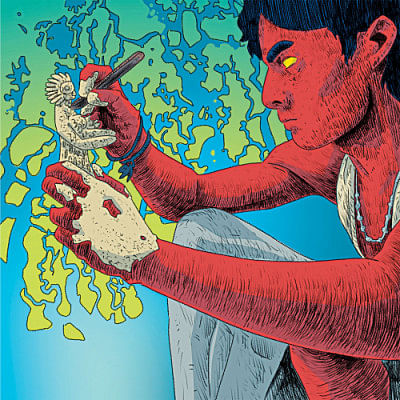Conservation through literature

Sarah Bari (SB): This series is different from the previous books HerStory has released—focusing on places instead of people. Why is this particular series important and what is it sharing with us?
Katerina Don: The River Tales series has 15 short illustrated stories about various elements of Bangladeshi heritage and culture. A team of brilliant illustrators worked to bring the stories to life for children and adults all over the world. There are books on crafts, theatre and music, architecture, and festivals. The architecture series features three locations which celebrate the rich cultural diversity of Bangladesh—the Armenian Church, Panam City, and Kantaji Temple. All three architecture series books were illustrated by Sayeef Mahmud. He was able to link the present day structure to its history in his wonderful illustrations.
The River Tales series is focused on the places, things, and traditions of Bangladesh. Like HerStories, it looks at history through a specific lens—that of heritage—and celebrates our unique identity. Since our team was behind the production, most of the characters in the books are girls interacting with older female characters. The books feature girls who travel, girls who learn, girls who ask questions, girls who keep their eyes wide open and celebrate their identity. This series is sharing the many small joys that exist around us, the fabrics, the rivers, the food, and the art, seen through the wonderment of a child's eyes. There is a tiger in the traffic. Can you spot it?
SB: How did you manage to include crucial information while keeping the language accessible for young readers?
Anita Amreen: While we were mindful of the younger audience, we didn't let that be the first priority behind the tone or choice of language—we wrote with the intention to engage and encourage a sense of wonder. If a place or story holds enough weight and is as magical as Kantaji Temple, you don't need to add too much detail or "dumb it down" for a younger audience. The best stories are simply told. While the language is simple, we held on to what anyone from any age would find interesting about such a temple—the mind boggling detail, the terracotta artwork of everything from dance parties to dragons.
As for the characters, we wanted to steer clear of stereotypical brother-sister duos and normalise opposite sex friendship. Nahian and Mira are friends who bond over the magic of a 300-year-old temple, one that Mira has visited but Nahian hasn't.
Katerina Don: There are reading level guidelines when writing for young readers to ensure that the language is accessible. Our goal was not to load the stories with facts but to inspire love for these traditions and a sense of pride and curiosity. Every country and people have a wealth of knowledge and memory that is unique and colourful and fascinating. We aimed to illustrate ours in a way that would inspire interest and admiration.
SB: What kind of research went into the project?
Katerina Don: The list of topics was selected by Asia Foundation and HerStory Foundation. We wanted to capture the diversity and uniqueness of Bangladesh and to create a series that would bring to light the wealth of traditions that exists in the delta. For example the festival series celebrates the language movement, the indigenous community, Old Dhaka flare, and the agrarian calendar. These are the ingredients that make us who we are—a beautiful chanachur of influences.
We recently visited the Armenian Church and met the caretaker's son who showed us around. We learned that his family had been taking care of the grounds for three generations and that they are Hindu. This is the harmony and cohesion we sought to celebrate in the series. We also learned that the Armenians were the ones to set up the jute trade in this part of Bengal. The interconnectedness of history is something important to note when celebrating heritage. Our cultural identity is an amalgamation, there is no such thing as "pure" and that is beautiful.
SB: What inspired the colour palette and style of artwork?
Sayeef Mahmud: I had a roommate back in 2017. He has a grand personality, is a surfer and wears very vibrant clothes. Until then I mostly worked in black and white but in 2018, I did a watercolour series with these colours and slowly, over the past few years, the palette has evolved to be what you see now.
I always liked architecture. And I really enjoy drawing buildings. While working on an illustration, the main task is to translate the concept well for everyone, be it from real life or fantasy. But getting to draw a favourite subject is always a treat.
SB: What are your distribution plans for the books? Where and how can people interact with them?
Katerina Don: At the moment we are planning a River Tales launch campaign on the HerStory and Asia Foundation Facebook pages. The campaign will start first week of March with a River Tales Reading Challenge, a 'Tiger in the Traffic Art Challenge' for which we ask participants to spot rickshaw art and post it to our page, and a Gold of Bengal Challenge for which people are welcome to send in images of interesting jute objects to celebrate National Jute Day (March 6). Winners will receive a limited-edition hardcopy of the River Tales. We hope to have the books available later in the year in print. They are free on www.letsreadasia.org in Bangla and English, easily accessible on both desktop and mobile.
For more book-related news and views, follow fb.com/dailystarbooks, @thedailystarbooks on Instagram, @DailyStarBooks on Twitter, and The Daily Star Books on LinkedIn. Send us ideas and book reviews to [email protected].

 For all latest news, follow The Daily Star's Google News channel.
For all latest news, follow The Daily Star's Google News channel. 



Comments